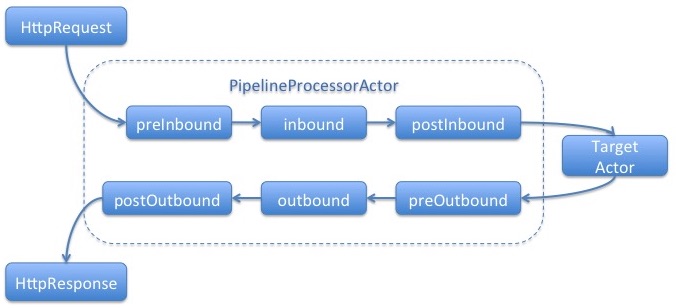Request/Response Pipeline Proxy
Overview
We often need to have common infrastructure functionality across different squbs services, or as organizational standards. Such infrastructure includes, but is not limited to logging, request tracing, authentication/authorization, tracking, cookie management, A/B testing, etc.
As squbs promotes separation of concerns, such logic would belong to infrastructure and not service implementation. The squbs proxy allows infrastructure to provide components installed into a service without service owner having to worry about such aspects in their service or actors.
Generally speaking, a squbs proxy is an actor acting as a bridge in between the service (Spray) responder and the squbs service. That is to say:
- All request messages sent from resonder to squbs service will go thru the proxy actor
- Vice versa, all response messages sent from squbs service to responder will go thru the proxy actor.
Proxy Binding
In your squbs-meta.conf, you can specify proxy for your service as follows:
squbs-services = [
{
class-name = com.myorg.myapp.MyActor
web-context = mypath
proxy-name = myProxy
}
]
Please check out Unicomplex & Cube Bootstrapping for more
information about squbs-meta.conf.
Proxy resolution rules:
- If you don't specify any proxy-name, i.e.: omit the proxy-name, squbs will install
a proxy named "default-proxy" provided with your system configuration in some
reference.conforapplication.conf. - If you set an empty string
""for proxy-name, no proxy is applied to the requests/responses for your service. - For any other name, squbs will try to load proxy the proxy definition and configuration from the system configuration provided through the merged
reference.confandapplication.conffiles.
Proxy Definition & Configuration
Following is the proxy definition required in the conf files:
myProxy {
type = squbs.proxy
processorFactory = org.myorg.myapp.SomeProcessorFactory
settings = {
// Proxy-specific configuration/settings here.
}
}
Explaining the fields:
myProxyis the name of the proxy which aligns with the binding insqubs-meta.conf.typemust besqubs.proxyto be recognized as a proxy declaration.processorFactoryis factory impl which can be used to create a proxy processor (Processoris discussed in a later section of this document).
scala
trait ProcessorFactory {
def create(settings: Option[Config])(implicit actorRefFactory: ActorRefFactory): Option[Processor]
}
* settings is an optional config object which can be used by processorFactory (as you can tell from the above create method).
Proxy Processor
Proxy Processor is used to describe the behavior of the proxy, like how to handle HttpRequest, HttpResponse, chunked request/chunked response, etc. It provides method hooks that allow implementers to define their own logic.
You can check the Processor definition.
This Processor will be used along with the proxy actor (in this case it is PipelineProcessorActor) to perform the proxy behavior:

Implementation of this processor is optional. In most cases you don't have to create an implementation of your own. squbs already provides a very lightweight pipeline based processor for you. This is described in the sections below.
RequestContext
As you might see from Processor definition, a class called RequestContext is widely used.
This class is an immutable data container which hosts all useful information across the request/response lifecycle.
Below is a basic structure of the RequestContext and corresponding response wrapper class information:

Pipeline Proxy
Touched upon above, squbs has a default simple pipeline processor implementation.
With this implementation, you can simply setup a proxy by:
1. Implementing handlers
Handler definition:
trait Handler {
def process(reqCtx: RequestContext)(implicit context: ActorRefFactory): Future[RequestContext]
}
HandlerFactory definition:
trait HandlerFactory {
def create(config: Option[Config])(implicit actorRefFactory: ActorRefFactory): Option[Handler]
}
You need to implement a HandlerFactory to create your handler instances.
2. Configuring the pipeline
Once you implemented the handler factory, it needs to be added to the configuration.
myProxy {
type = squbs.proxy
processorFactory = org.squbs.pipeline.SimpleProcessorFactory
settings = {
inbound = [handler1, handler2]
outbound = [handler3, handler4]
}
}
handler1 {
type = pipeline.handler
factory = com.myorg.myhandler1
}
handler2 {
type = pipeline.handler
factory = com.myorg.myhandler2
}
handler3 {
type = pipeline.handler
factory = com.myorg.myhandler3
}
handler4 {
type = pipeline.handler
factory = com.myorg.myhandler4
}
Or you might check sample config with description
For the above configuration:
processorFactorymust beorg.squbs.proxy.SimpleProcessorFactory.settings.inboundis the sequence of request handlers.settings.outboundis the sequence of response handlers.handlerX.typemust bepipeline.handler.handlerX.factoryis the name of a class that implements HandlerFactory
Again, if you want to have custom logic for other phases like preInbound or postOutbound, you can extend SimpleProcessor and create your own factory just like SimpleProcessorFactory
Default proxy
Squbs has a default proxy defined in squbs-unicomplex
So in your application, you can simply define your proxy config like this:
default-proxy {
settings = {
inbound = [handler1, handler2]
outbound = [handler3, handler4]
}
}
handler1 {
type = pipeline.handler
factory = com.myorg.myhandler1
}
handler2 {
type = pipeline.handler
factory = com.myorg.myhandler2
}
handler3 {
type = pipeline.handler
factory = com.myorg.myhandler3
}
handler4 {
type = pipeline.handler
factory = com.myorg.myhandler4
}